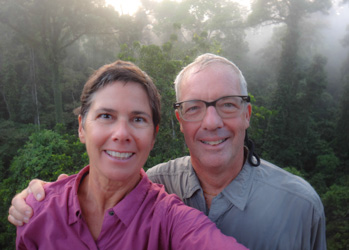
Tenaya
March
2014
Part Two
Danum Valley Conservation Area,
Kinabatangan River & Sepolik
Sabah, Malaysia, Borneo
| |
| HOME |
| About Tenaya |
| About Us |
| Latest Update |
| Logs from Current Year |
| Logs from Previous Years |
| Katie's View |
| Route Map |
| Links |
| Contact Us |
![]()
March 3, 2014
They crash through the trees with absolutely no grace whatsoever. They jump with abandon into the canopy grasping whatever branches they can reach, using their tails only for balance. They are silly looking creatures, Proboscis monkeys are. Males have long, floppy noses, big bellies and pronounced erections. Females have cute pointed noses, smaller bellies and are about half the weight of males. It's not hard to find them - just scan the trees for chaotic rustling.
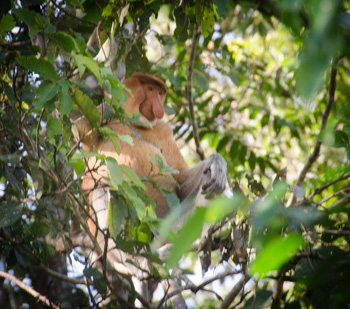
Male proboscis monkey
These strange looking monkeys are endemic to Borneo and are endangered. But Charlie said there was a good chance of seeing them on the Sungai Kinabatangan, the longest river in Sabah at 560 kilometers. The Lower Kinabatangan floodplain is a 26,098 hectare protected area surrounded by miles and miles of palm oil plantations. He booked a room for us at the Sukau Rainforest Lodge for two nights and we took boat rides morning, late afternoon and night to view the wildlife.
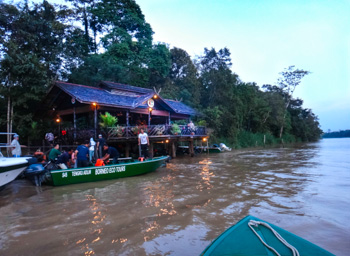
Sukau Rainforest Lodge
Our guide, Hazwan, found a group of proboscis monkeys early on our first ride and each subsequent daylight trip. He pointed out pig tail and long tail macaques, explaining that the long tail macaques sometimes fish for crabs with their tails. They travel in troupes of 30-40 and are the most common type of monkey here.
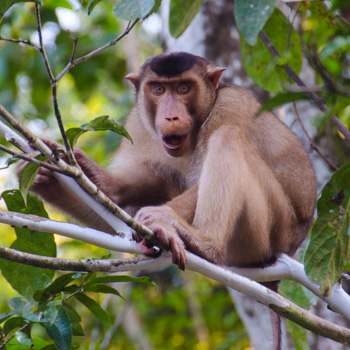
Adult long tail macaque
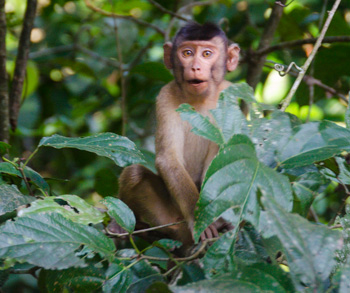
Juvenile long tail macaque
Gliding along the larger Kinabatangan river, smaller Menanggul river, and an oxbill lake using a super quiet electric motor, we were able to creep up on monkeys and birds.
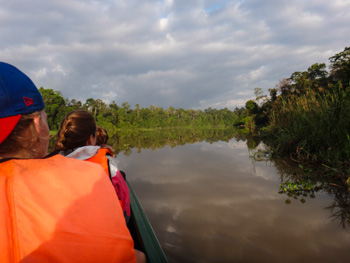
One of the 21 oxbill lakes on the Sungai Kinabatangan
During our night boat ride we saw a blue ear kingfisher and a stork billed kingfisher, two of the eleven types found here. We also saw this yellow bittern with enormous feet along with several other birds we didn't get photos of. We joked with the other three couples about seeing a snake during the trip. Soon Hazwan was guiding the boat under a tree and shining his flashlight at a mildly poisonous mangrove snake coiled up on a branch directly above us. Nobody dared ask about crocodiles.
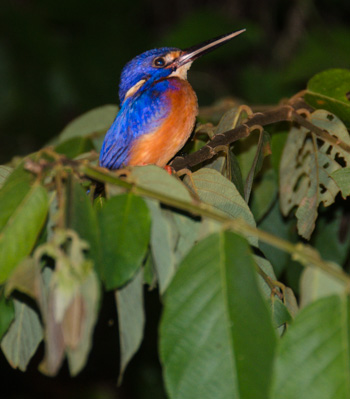
Blue ear kingfisher
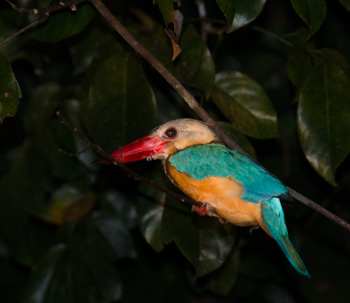
Stork billed kingfisher
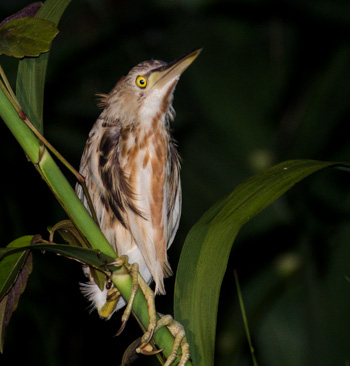
Yellow Bittern
Charlie picked us up from Sukau and half an hour later we picked Hatti and Ryan up from Hatti's village. We were on our way to Danum Valley but first had to stop in Lahad Datu to buy food for our five day adventure.
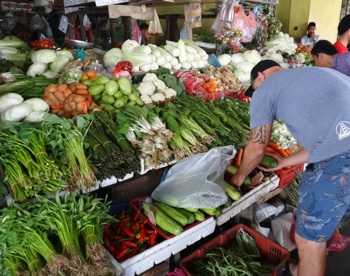
Market in Lahad Datu
"It's 30 leeches per hour," a researcher hoping to trap one of the few Sumatran rhinos left in Danum Valley said to the reporter, explaining why it was so slow and difficult to set traps. I read this in the newspaper a few days before we headed out there.
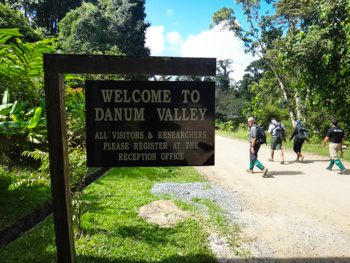
Danum Valley Field Centre
Danum Valley Conservation Area is a 438 square kilometer reserve in primary rainforest. The majority of the trees are dipterocarps which grow to astounding heights and block most sunshine from reaching the ground. Therefore, fewer types of underbrush exist here than in secondary rainforests. The seeds of dipterocarps glide long distances. They fall out of pods with wing-like protrusions that enable them to fly straight or swirl like a helicopter. Most creatures here live in the canopy. And most people here are researchers.
There are only two options for visitor accommodations, the high-priced Borneo Rainforest Lodge or the no-frills rooms and dorms at the field center. We hoped for rooms at the field center but a film crew was here working on a project with David Attenborough and they'd booked all the rooms so we stayed in the dorms. They were fine. We never saw Sir David, perhaps he stayed at the lodge.
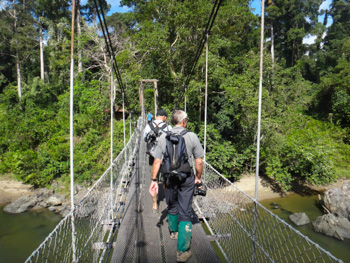
Armed with cameras, binoculars, leech socks, and slathered in DEET, we headed into the jungle to look for wildlife each morning, late afternoon and night. That is when animals and birds are most active. It didn't take long before Hatti and Charlie were pointing birds, bugs, mammals and reptiles.
We saw this small water monitor lizard swimming in the river after we'd seen two 2 meter long adults the previous day. Suffice it to say we kept a good lookout each time we went swimming or crossed the river!
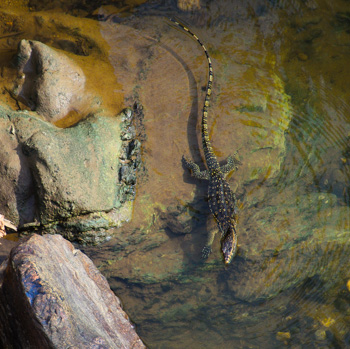
Water monitor lizard
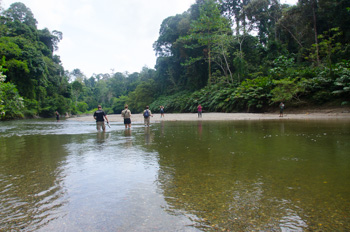
Leeches. Nasty buggers. Knee-high socks protected our lower legs and feet but our arms and bodies were fair game. They attach one end of their slimy bodies to your skin but it takes a while for the blood to flow so when we felt a little 'gummy snake' on our skin, we scraped it off with our fingernails, rolled it up in a ball and flicked it away. It took some time to get comfortable with this. Charlie and Hattie did not bother with leech socks and they were a bloody mess each afternoon. One of the suckers got Jim on the side the first night and left his shirt looking like he'd been stabbed.
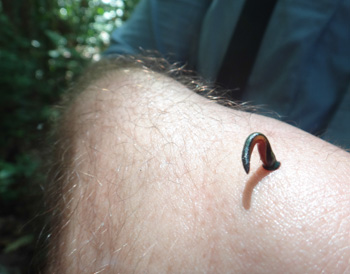
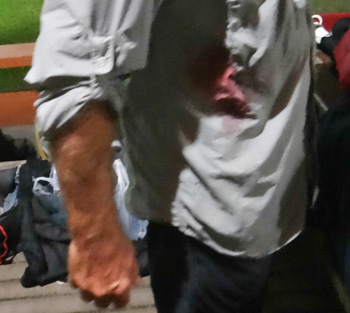
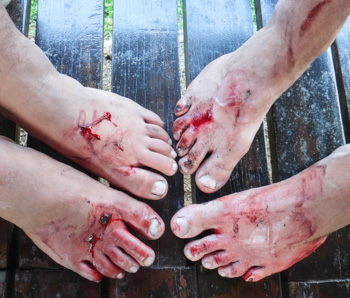
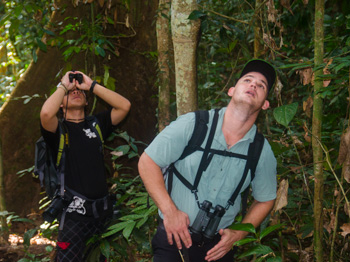
Hatti and Charlie were amazing at spotting wildlife
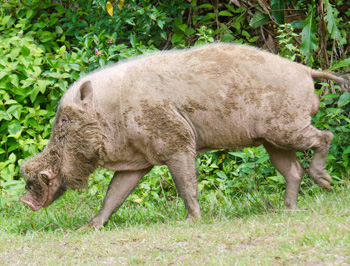
Male Borneo bearded pig
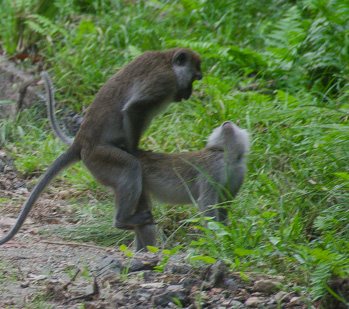
These macaques were running across the road in front of our truck with several others but still had time to stop for a quickie. Isn't it nice how they are looking into each other's eyes?
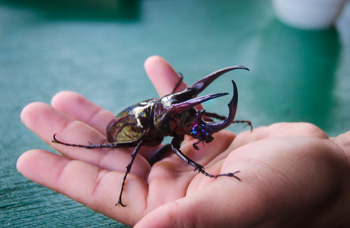
Rhinoceros beetle
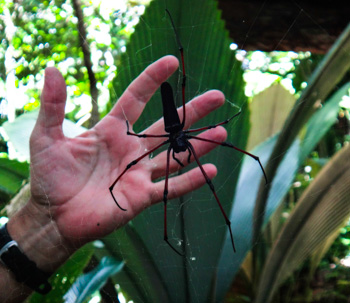
Makes the orb spiders in Australia look small
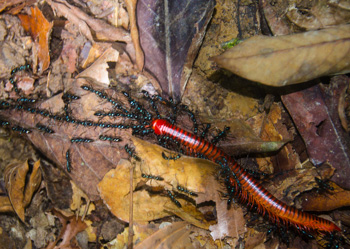
Ants link together to drag a dead millipede
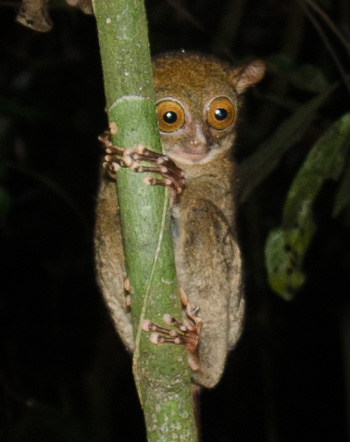
Western tarsier, pretty much the cutest creature in the rainforest
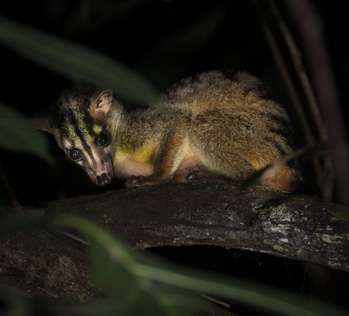
Banded palm civet cat
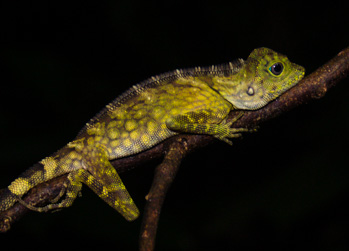
Mysterious lizard
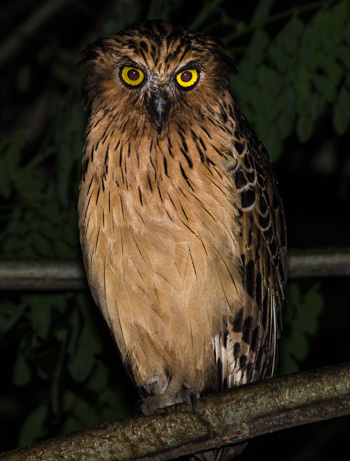
Buffy fish owl
Sometimes we didn't need to go far to see wildlife. Red leaf langurs like to hang out in the big tree right behind an employee housing building. Adults are darker, but juveniles are bright orange and curious little things.
"Look up there," Hatti said as we walked across the swing bridge over the river. Sitting in a tree devoid of most foliage, an orangutan was resting its head on limb. Another was slowly climbing along a different branch. The lazy one looked up a few times as we took dozens of photos and even stood up and posed.
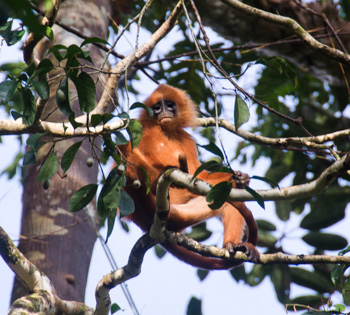
Juvenile red leaf langur

An orangutan rests in a tree just above the swing bridge
There is a female orangutan that lives near the field center and is often seen on the road. She can be territorial and it's best to give way to her. The freelance filmers said they'd seen her. One pulled out his phone and showed us video of her coming out of the bush and walking up to their set. "She came out, sat down in front of the monitor and just watched the screen," he said.
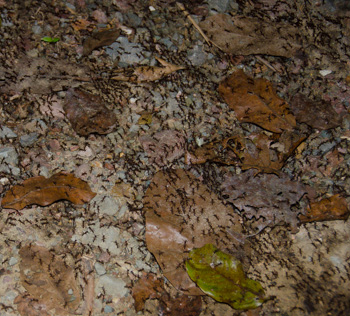
Fire ants. They only come out at night. Watch your step and don't stand in them.
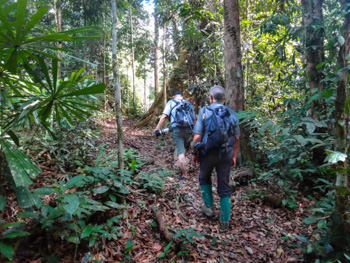
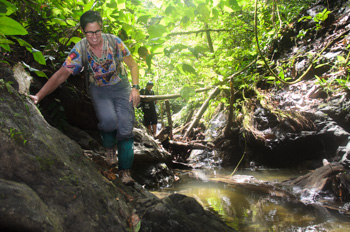
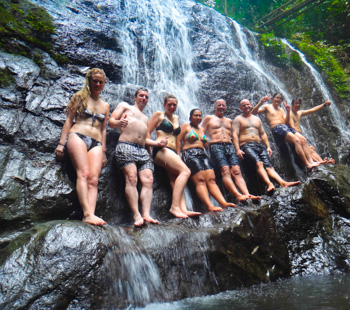
Our group hiked to this waterfall and had lunch and a refreshing swim
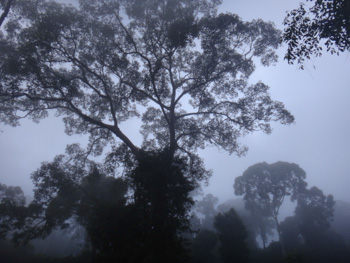
Dawn in Danum Valley
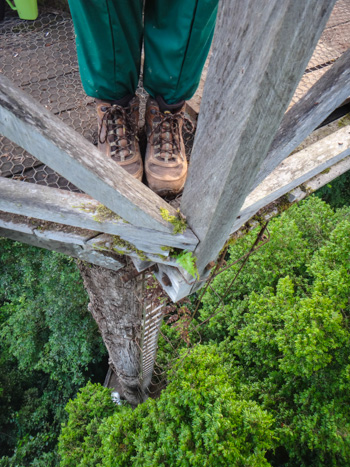
A ladder attached to a tree climbs 100 feet up to a lookout high in the canopy. The platform below is the half-way point.
After five magical days in Danum Valley we went back to Lahad Datu and took a taxi to Paganakan Dii, an eco-resort inside a deer preserve near Sepolik to visit the Orangutan Rehabilitation Centre, Bornean Sun Bear Conservation Centre and Rainforest Discovery Centre. Our favorite? The Sun Bears!
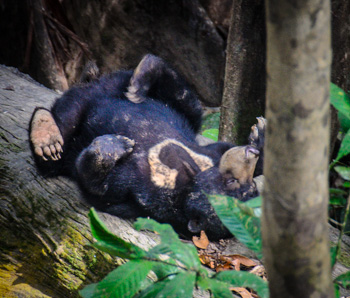
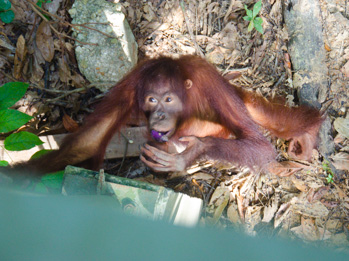
This male orangutan crept up to the platform where Jocelyn, a graduate student, was filming sun bears. She grabbed her tripod, camera and rucksack and left before he climbed up. Next he ambled over to where Jim, an employee, and I were standing on another platform. He stuffed a treat meant for the sun bears in his mouth and climbed up to the railing. The nervousness in the woman's voice assured we gave him plenty of room.
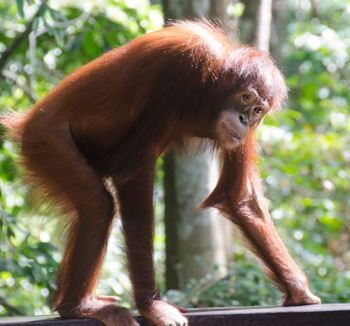
The goal of the Sepolik Orangutan Rehabilitation Centre is to return orphaned, injured or displaced orangutans back to the wild. Twice a day their natural diet is supplemented with milk and fruit and visitors can watch as they come to the platform.

The Rainforest Discovery Center is set in secondary rain forest and has a long canopy walk. We didn't see much wildlife but we did have lunch in a lovely setting.
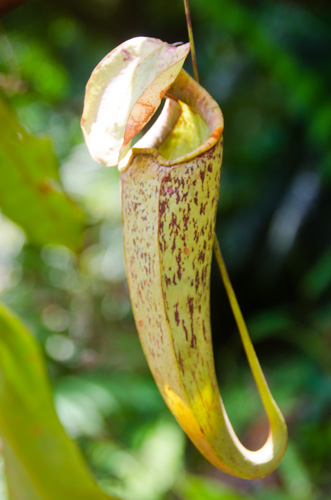
Pitcher plants are carnivorous
Vast amount of primary and secondary rainforests have been cleared for palm oil plantations. It brings a lot of money into the country and is where many local people earn their wages. The same few companies own most of the plantations. If someone has land and wants to plant oil palms, the government will deliver the trees for free. In four years the trees will be ready to harvest and will produce for 25 years.
It's actually a pretty sustainable crop, but the problem is greed. Plantations are so big, and many go right to the rivers' edge, leaving no place for animals to move. Electric fences are built to keep pygmy elephants out and they do, often killing them. The plantations separate bits of remaining forest by such distances that many species cannot travel to mate. 80% of the animals cannot live in palm oil plantations and the extent of these plantations is staggering.
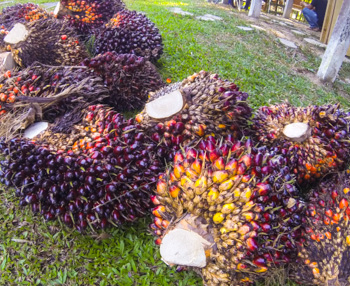
But there is a glimmer hope. Some companies are responsible. They are keeping at least 50 meters of the forest along the rivers for a corridor for the animals and they are replanting 10% of their land with dipterocarps.
Some people are beginning to see that eco-tourism can be financially important, that people will pay money to see animals so they are worth more alive than dead. Education and awareness are key.
The creatures we saw in the wild: orangutans, pig tail and long tail macaques, red leaf langurs, Borneo gibbons, two western tarsiers, mouse deer which are about the size of a Jack Russell terrier, sambar deer, bearded pigs, Prevost's squirrels, giant red flying squirrels, malay civit, banded palm civit, pen-tailed tree shrew, raffles malkoha, spotted fantail, crested fireback pheasant, whiskered tree swift, magpie robin, black eagle, scarlet rump trogon, siberian blue robin, hooded pitta, arctic warbler, oriental pied, asian black, bushy crested and rhinoceros hornbills, yellow bittern, black and yellow broadbill, blue eared and stork billed kingfishers, brahminy kite, bat hawk, black crowned night heron, water monitor lizards and various small snakes, lizards, frogs, beetles, termites, ants and moths.
We heard argus pheasants and Charlie saw a slow loris but we didn't.
Go to March 2014 Part Three - Singapore
